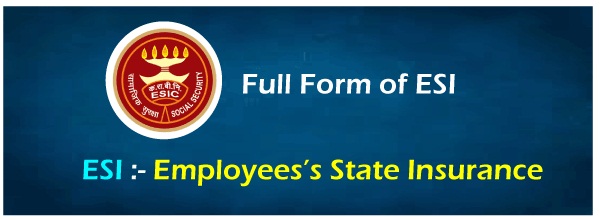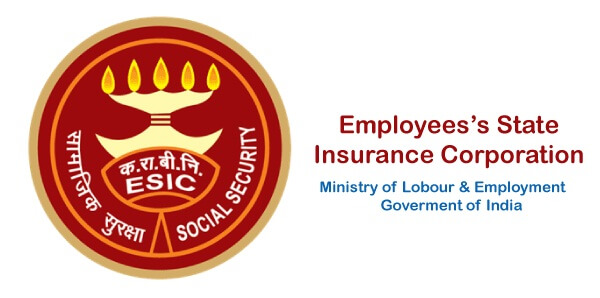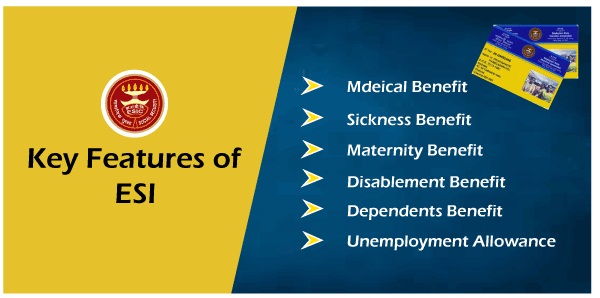ESI Full Form
Full Form of ESI – Employees State Insurance
ESI is the abbreviated form of Employees State Insurance. It refers
to the health insurance plan. It is a plan or scheme that offers the workers or labourers of India with benefits. These benefits include medical, cash or bonus, etc.
This ESI plan is lead, controlled, or regulated by ESIC- Employees State Insurance Corporation. ESIC is an independent and self-ruling body that falls under the Ministry of Labour and Employment, Government of India.
ESI is a statutory health insurance project that was launched in February 1952. Employees State Insurance is a self-finance or social security scheme or plan of health insurance for the workers of India. The funds of ESIC are managed as per the rules, regulations mentioned in the ESI Act 1948.

ESIC has it’s headquarter in New Delhi, and as of 2017, Sh. Raj Kumar is the Director-General of the same.
History
- Professor B.P. Adarkar was delegated by the government of India in 1943 to make a report on the health insurance plan for the workers employed in the Industries.
- This report that was given by the Professor became the base for the ESI Act of 1948. The declaration or the issuance of the ESI Act 1948 planned the need for the emergence of a scheme keeping in mind the social insurance and protection of other interests of the workers.
- These include sickness, maternity, physical disabilities- temporary or permanent, deaths related to the employment places or spaces.
- It even includes other aspects of injuries that have hampered or led to the loss of wages or the earning capacity of the workers or their families.
- This scheme or the Act also ensures proper good medical care, attention to the workers and to their families or dependents.
- Soon after launching and initiation of the ESI Act, ESI Corporation was set up in order to overlook or administer the scheme of ESI.
- ESI Scheme was initially executed at Kanpur and Delhi in February 1952. This Act further informed the employers about the responsibilities or commitments under the Maternity Benefit Act 1961, Women Compensation Act 1923.
- The benefits provided or served to the workers are also in compliance with the ILO conventions.
- This Act was initially for the workers employed in the factories but then later became applicable to all the institutions- including those having more than 10 employees.
- As per 2016, the total number of employees that benefit from this scheme were 82.8 million, and the budget as per 2021 is 80,000 crore.
Key Objectives of ESI
ESI Act, 1948 was exclusively set up/ established to provide financial help to the workers during the incidents like temporary or permanent disabilities, maternity sickness, or death due to employment injury.
This Act or scheme also provides medical benefits to workers or labourers that are not employed or working in the factories or Industries. It is also applicable to those working in companies, provided the strength of the company is more than 10 workers.

Organizations under ESI
- This ESI scheme is essential and mandatory for all over India in all the states except in states like Arunachal Pradesh and Manipur.
- The ESI scheme or plan for the employees has become more broad over the time. It now also includes movies, cinemas, hotels, stores, outlets, etc.
- ESI scheme is available to all the employees and workers, even in medical organisations and private organisations or institutions.
- Essential Documents for ESI Registration
- There are few documents that are essential for ESI registration. These include;
- PAN card of the business organisation or the company
- Address proof of the business organisation or establishment.
- Copies of the registration certificate need to be submitted if the organisation is Private Limited.
- Registration Certificate of each and every organisation that is there.
- A complete list that has all the details of the employees, including the monthly income that is given to the employees.
- A complete list that consists of all the details of the associates, directors, and shareholders of the organisation or corporation.
- Another important document includes the bank statement or financial statements of the company that provides proof of commencement of the operation.
ESI Benefits
ESI has various benefits or advantages for the employees. There are various benefits that are provided to the employee and their family members. The two benefits include;
Medical and Cash
The other benefits that are provided under the ESIC Act include;
Sickness Benefit; Maternity Benefits, Dependent and Disability Benefits; Funeral benefits.
So ESI serves its employees with medical coverage in case of an accident, disability, pregnancy, and even death. There are various economic benefits also for those during unemployment- which includes unemployment allowance.

New Amendment
The ESIC has increased the monthly wage limit to Rs 21000 from the current Rs.15000, with effect from 2017. The rate of contribution was minimised from 6.5% to 4%- employer’s share 3.25% and employees share 0.75%- from 2019.